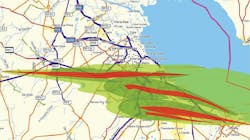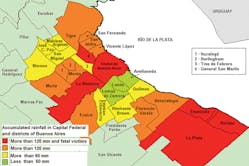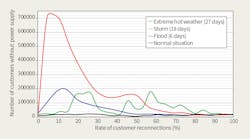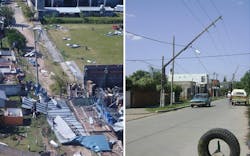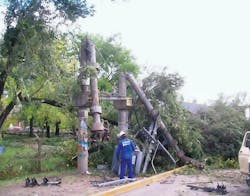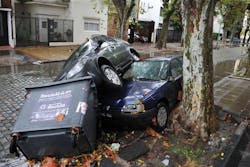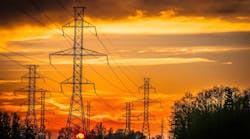Empresa Distribuidora y Commercailizadora Norte is Argentina’s largest distributor of electrical energy, supplying almost 3 million customers with a maximum demand of 4940 MW. The utility has experienced an increasing number of severe weather conditions in recent years. These events have caused large-scale destruction to the utility’s distribution network, disrupting electricity to a significant number of customers. Faced with major outages caused by climatic conditions, Empresa Distribuidora y Commercailizadora Norte (Edenor) seeks to ensure customer safety and the restoration of customer supplies in the shortest time possible.
The requirement of an emergency operational plan (EOP) was established by Argentina’s industry regulator in 1999 (Resolution 905/99), and Edenor implemented it that same year in the form of Standard NG3 and General Procedures PG No. 3001/7. These detail the criteria and contingencies for activation of the EOP in adverse climatic conditions as well as specify the utility’s standards for restoration of supplies. When the probability of a major climatic contingency is imminent, Edenor moves to a precrisis operation whereby the managers of all operational units must ensure they have adequate staff and resources available. Likewise, the companies supplying Edenor with goods, materials and services also are expected to take similar actions.
In general, the frequency of weather phenomena is increasing in association with climate change that has been occurring in recent decades at an even more accelerated rate. Climatological events that have had a major impact on Edenor’s distribution network can be classified into three types: excessive wind speeds, excessive rainfall and high ambient temperatures.
Wind Speeds
Strong winds greater than 120 kmph (75 mph) causes major damage to overhead lines. Although the lines are designed to withstand these wind speeds, they are affected by falling trees and windborne objects, which can result in short circuits and damage to the overhead line conductors.
On April 4, 2012, a strong meteorological event affected most of the towns bordering Buenos Aires. Reports from the National Meteorological Service confirmed during this intense storm at least four tornadoes had formed, two of which were classified as F2 category, a wind speed range of 113 mph to 157 mph (181 kmph to 253 kmph), and the other two as F1 category, a wind speed range of 73 mph to 112 mph (117 kmph to 180 kmph).
The most severe recorded damage from the tornadoes was in an area 70 km (43.5 miles) in length with a width varying between 1500 m and 2000 m (4921 ft to 6562 ft). Within a period of 20 minutes, the storm was long enough to create landslides, falling trees, road traffic accidents, and movement and damage to parked vehicles. A few hours later, the first reports of fatalities, injuries, evacuations, flooded areas and power outages were received.
This storm is the most destructive in history affecting the metropolitan area of Buenos Aires and La Plata, and it had a catastrophic impact on the overhead lines in Edenor’s distribution network. In the first four days following the storm, 5.5 million fallen trees and branches were removed. A total of 79,760 trees had to be cut down or destroyed. Around 1400 streets were closed, some for weeks, because of the obstructions caused by trees, poles and debris.
Rainfall Density
Extreme weather in the form of heavy rainfall for a short time—defined as continuous rainfall of more than 50 mm/hr (1.97 inches/hr) that lasts for several hours—has caused flooding because of poor drainage, which ultimately affects Edenor’s underground installations. An example of an extreme rainfall event was flooding that affected the northeast part of Buenos Aires Province, mainly the federal capital and La Plata city, between April 1, 2013, and April 3, 2013. Precipitation records identify this as a historic record for April in the Argentine capital with more than 155 mm (6.1 inches) of rain accumulating between midnight and 7 a.m. on April 2. A rainfall totaling 392 mm (15.4 inches) fell during the 24-hour period.
In the federal capital, the distribution network was damaged severely by the accumulation of rainwater, which resulted in 11 neighborhoods in Buenos Aires being without an electricity supply, in many instances, preventively and at the request of government agencies. Also, train services and the Buenos Aires subway were suspended because of the storm. The city transportation system also was affected, with flooding in the capital and neighborhoods of Buenos Aires
Excessive Ambient Temperatures
When the maximum daily temperature exceeds 35°C (95°F) for several days, this is considered excessive ambient temperatures. With high temperatures, electricity demand increases because, among other reasons, the number of air-conditioning units in use increases. These temperature conditions prevent dissipation of the heat generated in underground cables and overhead line conductors. Subsequently, the increased current flow increases the risk of damage to and the failure of these assets.
From Dec. 11, 2013, to Jan. 2, 2014, Argentina experienced the longest heat wave since records began in 1906. It affected 52 cities located in the north and center of the country in addition to the north of Patagonia, which is south of Argentina. This was the first time since the formation of the EOP system a heat wave had triggered an alarm. Temperatures were 4 C ° (7.2 F °) above average at minimum and 6 C ° (10.8 F °) above average on the hottest days. The long-term duration of this heat wave, which lasted for 22 days, made the event exceptional, breaking several records for the number of consecutive days with temperatures well above average.
On Monday, Dec. 23, the Federal Planning Ministry reported the Argentine interconnection system had exceeded the power demand record for one business day, when demand reached 23,793 MW at 2:20 p.m. Likewise, on Dec. 28, a record was set for power demand on a Saturday, when demand reached 21,264 MW at 2:10 p.m.
EOP Activation
When the National Meteorological Service forecasts excessive rainfall or any other severe climatological event, Edenor moves to precrisis operation. When events produce an interruption to the supply of electrical energy that affects a significant number of customers or is estimated to take a prolonged time to restore, these conditions warrant activation of the EOP. The general conditions activation (GCA) procedures rely on taking advantage of the utility’s management experience and making the correct evaluation of the situation.
Edenor’s director of distribution is responsible for activating the EOP by forming a centralized emergency committee and convening the utility’s local emergency committees, which notify the rest of the organization of the situation, so each director makes available the resources required.
This promotes predetermined procedures at all operational units, which includes suspending all scheduled tasks, ensuring staff and resource availability including contractors, and a role review of functions, work patterns and objectives. The predefined tasks within the EOP include the following activities:
Field teams review installations and determine damage to medium-voltage and low-voltage (MV and LV) overhead lines following excessive winds and underground installations in the event of excessive rainfall. These tasks are performed by the field teams responsible and authorized to work on MV and LV network assets. Each team is equipped with network diagrams and communication equipment.
Evaluating and assigning repairs, including the prioritization of repairs, is undertaken to identify potential risks to public safety, time of interruption of supplies and the number of customers affected. Also, Edenor staff communicates with public services as needed (hospitals, health centers, fire and police stations, transport services and electro-dependent clients).
Assigned staff are responsible for the supervision of repairs, providing progress updates to the group coordinator, and delivering and receiving the facilities to be repaired.
Assigned personnel manage the damage claims associated with the application (EOP), documenting all damage to inform the regulator.
The same personnel handle all specific government entity complaints and share them with the information management group for evaluation. They are also responsible for dealing with all supply issues that affect other public services, for example the supply of drinking water.
Staff are assigned to manage the resources requested by the operating areas as well as handle supply and logistics, telecommunications, information systems, transportation, security, and patrimonial protection and legal affairs.
Specialist staff with communication skills are available as required to interact with the local press, customers, and all large power users and major customers affected by the event. Depending on the magnitude of the meteorological phenomenon as well as the degree of damage and disruption to the distribution network, all groups are divided in two, each completing 12-hr work shifts until the EOP ends. When service conditions return to normal and can be controlled with the usual resources, Edenor’s director of distribution deactivates the EOP.
Customers Affected
In the case of excessive winds and rainfall, the number of customers without supply reaches a peak in the first few hours and the number decreases as the repairs are completed progressively over time. However, when a heat wave occurs, the number of customers affected varies because it depends on the intensity and duration of the heat wave. In this case, customers who have their supply restored are replaced by other customers without a supply, because of a new failure in another section in the distribution network. Progressive normalization will be achieved when the speed of repair and normalization of energy supply exceeds the speed of failure generation, a situation generally linked to an improvement in the climatic conditions.
It should be clarified that the supply regulations foresee the inclusion of a compensation scheme based on the frequency and duration of supply interruptions. This varies according to a customer’s maximum power (MD) demand. Low and medium power customers are those with an MD of less than 50 kW, while large power customers have an MD greater than 50 kW.
Continuous Improvement
To achieve continuous improvement in the EOP, it is important to hold a debriefing session following each event to review and evaluate all the procedures. Also, it is necessary to undertake an annual review of the EOP, including staff training.
Finally, it is important to continually review the availability and adequate number of trained staff and equipment, for example, generators, hydraulics trucks, cranes, provision of fuel, drain pumps, tools, materials and potential suppliers. Additionally, these annual reviews should include having an updated agenda with fire departments, civil defense, municipalities, police stations, neighborhood representatives and social organizations.
Miguel Pulice ([email protected]) graduated in electronic engineering in 1988 and joined Empresa Distribuidora y Commercailizadora Norte S.A. (Edenor). He started with the utility as a supervisor, progressed to the head of department and then to assistant manager, in which he was responsible for network investment, preventive maintenance and operations until 2014. Pulice then was appointed to regional manager. He also has enjoyed a teaching career for over 17 years as professor of digital techniques and circuit theory. Pulice is a regular attendee and exhibitor at the International Conference & Exhibition on Electricity Distribution (CIRED), held every two years in Europe.
For more information:
- Edenor | www.edenor.com.ar

